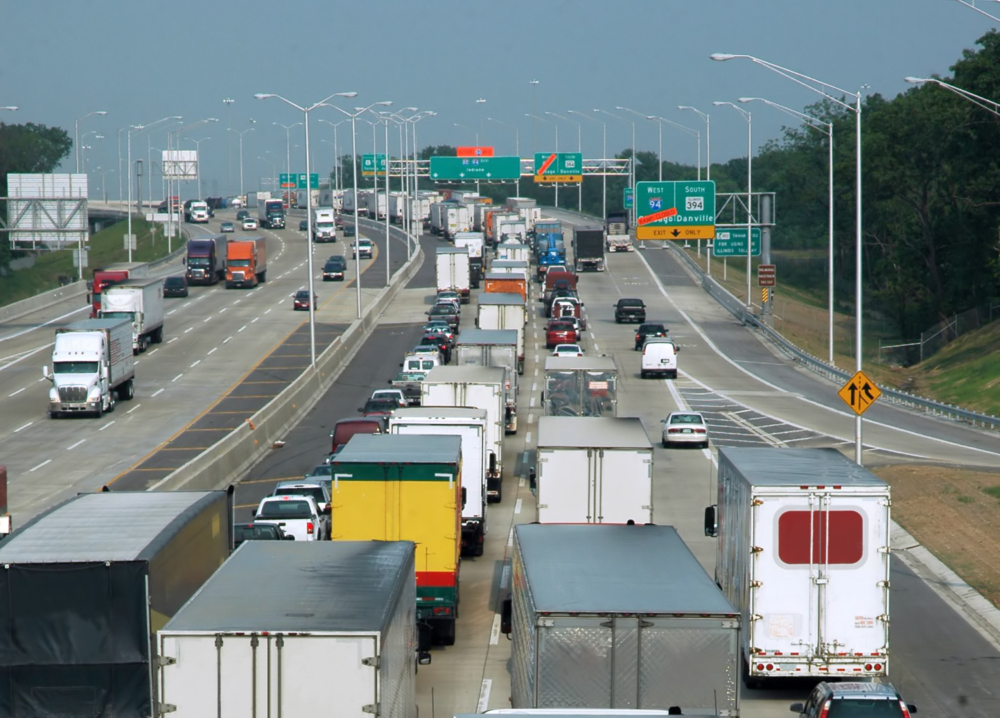The State of U.S. Transportation Infrastructure and Its Impact on Manufacturing
It is no secret that America’s aging infrastructure is in dire need of attention—it’s one issue our nation’s business, economic and elected leaders find consensus on across the board. It’s obvious why a poorly maintained infrastructure is bad for manufacturing—if interstate lanes are blocked by construction for long periods of time, or the speed limit is reduced on a bridge due to structural deficiencies, it creates bottlenecks, congestion and puts a kink in delivery schedules.

For the U.S. manufacturing industry—and the economy overall—to remain globally competitive, it’s imperative to have a 21st-Century infrastructure that not only allows for timely delivery of product to market, but is reasonably priced as well.
So what are the biggest problems and how severe are they? Every four years, the American Society of Civil Engineers (ASCE) issues a report card on the state of U.S. infrastructure, and the results are nothing short of alarming. Overall, ASCE gives the U.S. infrastructure a D-plus grade point average.
ASCE broke it down further by type of transportation infrastructure to hone in on where the real problems lie and how much investment each system needs now to be ready for the demands of the future. Each category was evaluated on the basis of capacity, condition, funding, future need, operation and maintenance, public safety and resilience.
Earning a grade of D were aviation, roads, inland waterways and transit. Ports, bridges and rail faired somewhat better with C averages.
The report points to the vast increase in commercial enplanements—33 million more in over an 11-year period—for the clogging and congestion at terminals, costing about $22 billion in delays in just one year, according to the Federal Aviation Administration (FAA). Congestion and delays to the economy will rise from $34 billion in 2020 to $63 billion by 2040 if federal funding stays as is.

Highways remain congested—some 42 percent fall into this category. This costs the economy about $101 billion in wasted time and fuel each year. The Federal Highway Administration says it would cost about $170 billion annually to make significant improvements. And without structurally sound bridges, highway traffic slows even more. Currently, about one in nine of the country’s over 600,000 bridges are classified as structurally deficient.
Some U.S. manufacturing sectors rely on inland waterways for the delivery of large amounts of freight but the system hasn’t been updated since the 1950s. With backed-up waterways, barges sit for hours, costing manufacturers precious time and money. And because 95 percent of international trade is shipped via waterways it’s essential for U.S. ports to be ready to handle the ever-increasing volume. Despite this, federal funding has declined for port upgrades, placing most of the burden on state port authorities and private investors.
The number of Americans who use the public transportation system continues to increase, and that’s not expected to slow down any time soon. While investment is up in transit, deteriorating fleets and facilities are costing the economy tens of billions of dollars.
There is one bright spot on the ASCE report card, however: rail. While this mode of transportation received an average C grade, rail companies have invested heavily in upkeep and renewal of rail lines and yards, fueled by an increase in demand for its services due to congestion in other parts of the transportation network.
Maintenance and rehabilitation of transportation infrastructure is largely funded by the federal government, with the exception of rail. The Highway Trust Fund was established by Congress in 1956 and generates revenue via a fuel tax to fund infrastructure improvements, mostly for roads and bridges. The tax currently stands at 18.4 cents per gallon of gasoline and 24.4 cents per gallon of diesel fuel, but has not been raised since 1993. The revenue generated by this tax is insufficient to pay for a good portion of infrastructure projects waiting in the queue.
In an election year, it’s not uncommon for political hopefuls to cite the issue as one they will prioritize if elected to office. But no matter how much infrastructure is discussed, Congress continues to all but ignore the problem.
The U.S. House of Representatives recently passed yet another short-term extension to the Highway Trust Fund—a move experts agree is inadequate.
“Current funding levels alone will never help the U.S. climb out of its growing infrastructure gap,” said Robyn Boerstling, director of transportation and infrastructure policy for the National Association of Manufacturers. “There is a ten-year backlog of essential infrastructure projects that must move forward and a status quo trajectory will not be sufficient. Manufacturers often remind policymakers and elected officials that the potential to increase productivity, grow the economy and increase jobs are important incentives to address the nation’s well documented infrastructure challenges. It is time for manufacturing voices to be heard.”
And while the U.S. drags its feet, key competitors in Europe and Asia are investing in infrastructure, threatening the U.S.’s leading position in the global marketplace. According to the World Economic Forum, the U.S. ranks 11th in quality of overall infrastructure, behind other developed countries like France and Japan.
Andy Hermann, a seasoned bridge engineer by profession and past president of ASCE, speaks frequently on the topic on behalf of ASCE across the country. He says the organization has gone to great lengths to not only study where the problems lie within America’s infrastructure, but has commissioned studies on what happens if the U.S. fails to act.
“What if we just keep on investing at the same rate we have for the last five-to-ten years, up to 2040?” he said. “What happens to the country? What happens to families? What happens to businesses? If we just keep on going at this rate, it’s going to have a pretty nasty effect on those categories.”
ASCE’s Failure to Act report predicts a $3.1 trillion loss in gross domestic product; a $1.1 trillion loss in U.S. trade value; and the loss of 3.5 million American jobs.
“You’re also looking at a loss of $2.4 trillion in consumer spending and—when you bring it down to the family level—it’s going to hit each family for $3,100 a year by 2020,” Hermann explained.
While the future looks bleak if nothing is done, Hermann says the solution is quite simple: more federal investment.
“If we invest $157 billion a year, we could eliminate those drags on the economic growth,” he said. “It’s a no-brainer, but nobody really wants to act on it.”
Why not? Hermann says it basically comes down to politics.
“Infrastructure rehabilitation and maintenance is simply not sexy,” he said. “You can’t get the governor to cut a ribbon on a bridge paint job.”
Furthermore, he says, the American people don’t want to pay extra, and politicians don’t want to force them.
“We’ve benefited from our grandparents and great-grandparents investments and we’re just not holding up our end of the deal,” he said. “We’re supposed to be improving and maintaining it for the future.”
On a more positive note, Hermann says states are stepping up to do what they can to supplement the federal investment shortfall and plan for future infrastructure needs, including state tax increases.
“One of the things we’ve found from bond issues or sales tax increases, if you tell the public what you’re going to use that money for, they are much more inclined to vote for it,” he said.
Hermann gave Orange County, California as an example. The county voted for a ten-year sales tax and the revenue generated from the tax was specifically earmarked for infrastructure projects.
At the end of this ten-year period, more projects still needed to be executed, so Orange County put the sales tax back up for a vote.
“The people said yes,” Hermann said of the vote’s outcome. “So, people are satisfied if they can see things getting done. They want to see something happening with their money, and it not just dissolving into other government programs.”
- Category:
- GrayWay
- Manufacturing
Some opinions expressed in this article may be those of a contributing author and not necessarily Gray.
Related News & Insights
Manufacturing
Is One of America’s Oldest Modes of Transportation Part of the Solution to Its Infrastructure Woes?
GrayWay
Manufacturing
The New Face of Manufacturing: Promising Innovations that Could Revolutionize Infrastructure
GrayWay
Distribution, Robotics & Vision Systems
Shining a Light on the Lack of Fully Automated "Dark Factories"
Industry
January 06, 2026
